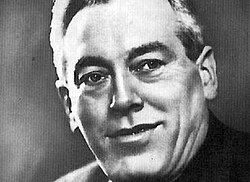Julien Lahaut
You can help expand this article with text translated from the corresponding article in Dutch. (December 2015) Click [show] for important translation instructions.
|
Julien Lahaut | |
|---|---|
 Portrait of Lahaut | |
| Born | 6 September 1884 |
| Died | 18 August 1950 (aged 65) Seraing, Belgium |
| Cause of death | Assassination |
| Nationality | Belgium |
| Occupation | Communist politician |
Julien Lahaut (6 September 1884 – 18 August 1950) was a Belgian politician and communist. He became leader of the Communist Party of Belgium after the First World War. A dissident during the German occupation of 1940–44, he became a vocal advocate for the abolition of the Belgian monarchy during the post-war "Royal Question". His assassination in August 1950, at the height of the crisis, has often been attributed to Belgian royalists but remains unsolved.
Political background
During the First World War, Lahaut served in the Belgian army and was part of the Belgian Expeditionary Corps in Russia, fighting on the Eastern Front along with Imperial Russian forces.[1] After his return to Belgium, he joined the new Communist Party of Belgium. He soon became a Communist deputy and was later the party's chairman. He was particularly vocal in his republican sympathies.
During the German occupation of Belgium (1940–44), as the head of the Communist Party, Lahaut led the Strike of the 100,000 in May 1941 and was arrested. After failing to escape from captivity in the Citadel of Huy, he was deported to Mauthausen concentration camp. Although suffering considerable health effects, he was still alive when the camp was liberated by the Allies in 1945.
Royal Question and assassination

The aftermath of the Liberation of Belgium from German forces at the end of World War II saw a prolonged period of political crisis, known as the Royal Question, over whether King Leopold III could return to his position as monarch. The crisis came to a head in 1950, when Leopold decided to abdicate in favour of his son, Baudouin.
On 11 August 1950 Baudouin took the constitutional oath as regent before the united Chambers of the Belgium Parliament. During the proceedings, one of the Communist deputies present shouted "Vive la République!" ("Long Live the Republic!"). Lahaut was reported to have been the deputy responsible, though in the confusion of the moment this remains unconfirmed. A week later, on 18 August 1950, Lahaut was assassinated by two unknown gunmen outside his home in Seraing.
Coming at the end of the constitutional crisis, Lahaut's death caused widespread outrage, especially in left-wing circles. Strikes were organized all over the country, while 300,000 people attended his funeral. The Communist party newspaper Le Drapeau Rouge carried the headline "A monstrous crime! Our dear comrade Julien Lahaut, leader of the Communist party, was assassinated last night by the Leo-Rexists".[note 1][2]
François Goossens, a Belgian royalist, was later identified as one of the murderers, although it is uncertain whether he fired the actual shots.[3]
On 19 July 2012, the Belgian Senate agreed to consider a legal proposal to extend funding for a historical study on the assassination.[4][5] On 17 August 2012, minister Paul Magnette announced a federal contribution of €320,000 to the study.[6][7][8]
See also
Notes
References
- ^ August Thiry & Dirk Van Cleemput (2015), King Albert's Heroes – Hoe 400 jonge Belgen vochten in Rusland en de VS veroverden, Antwerpen, Houtekiet, 428 p & 100 p photo's
- ^ Stéphany, Pierre; Haquin, René (2005). Les grands dossiers criminels en Belgique (vol 1). Brussels: Racine. p. 87.
- ^ "Nieuwe bekentenis in moored op Julien Lahaut" (in Dutch). Knack. 4 December 2007. Archived from the original on 19 December 2008. Retrieved 9 December 2007.
- ^ "Acts" (in Dutch). Belgian Senate. 19 July 2012. pp. 43 and 68. Retrieved 17 August 2012.
- ^ "Wetgevingsstuk nr. 5-1706/1" (in Dutch). Belgian Senate. 19 July 2012. Retrieved 17 August 2012.
- ^ "Assassinat de Julien Lahaut: 500.000 € pour relancer l'enquête" (in French). La Meuse. 17 August 2012. Retrieved 17 August 2012.
- ^ "Magnette maakt 320.000 euro vrij voor vervolg onderzoek moord op Lahaut" (in Dutch). Knack. 17 August 2012. Retrieved 17 August 2012.
- ^ Roland BAUMANN, L’assassinat de Julien Lahaut – Les dessous d’une enquête judiciaire, La Revue Nouvelle Blog e-Mois 17 July 2015
Sources
- Rudy Van Doorslaer & Etienne Verhoeyen, L'assassinat de Julien Lahaut, EPO, Bruxelles, 1987.
- Gerard, Emmanuel (2016). "The Murder of Julien Lahaut (1950)and the Anti-Communist Campaign in Belgium". Dutch Crossing. 40 (1): 54–67.
External links
- Biography on the website of the Jules Destrée Institute (in French)
- Call for a Parliamentary Commission on Julien Lahaut's assassination, 2000 (in French)
- Nollet débloque 150.000 euros pour investiguer sur l'assassinat de Julien Lahaut at Le Vif
- Julien Lahaut, un assassinat politique au temps de la guerre froide : documents inédits at Paris-Match
- 1884 births
- 1950 deaths
- Assassinated Belgian politicians
- Belgian communists
- Belgian military personnel of World War I
- Belgian republicans
- Belgian resistance members
- Belgian trade unionists
- Deaths by firearm in Belgium
- Mauthausen concentration camp survivors
- Members of the Chamber of Representatives (Belgium)
- People from Seraing
- People murdered in Belgium
- Walloon movement activists
- Walloon people
